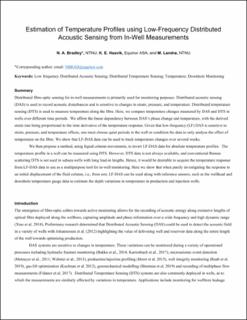| dc.description.abstract | Distributed fiber-optic sensing for in-well measurements is primarily used for monitoring purposes. Distributed acoustic sensing (DAS) is used to record acoustic disturbances and is sensitive to changes in strain, pressure, and temperature. Distributed temperature sensing (DTS) is used to measure temperature along the fiber. Here, we compare temperature changes measured by DAS and DTS in wells over different time periods. We affirm the linear dependency between DAS’s phase change and temperature, with the derived strain rate being proportional to the time derivative of the temperature response. Given that low-frequency (LF) DAS is sensitive to strain, pressure, and temperature effects, one must choose quiet periods in the well or condition the data to only analyze the effect of temperature on the fiber. We show that LF-DAS data can be used to track temperature changes over several weeks.
We then propose a method, using liquid column movements, to invert LF-DAS data for absolute temperature profiles. The temperature profile in a well can be measured using DTS. However, DTS data are not always available, and conventional Raman scattering DTS is not used in subsea wells with long lead-in lengths. Hence, it would be desirable to acquire the temperature response from LF-DAS data to use as a multipurpose tool for in-well monitoring. Here, we show that when purely investigating the response to an initial displacement of the fluid column (i.e., from rest), LF-DAS can be used along with reference sensors, such as the wellhead and downhole temperature gauge data to estimate the depth variations in temperature in production and injection wells. | en_US |

